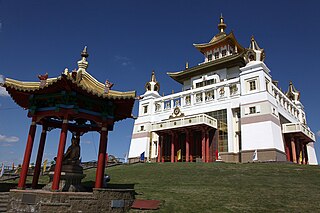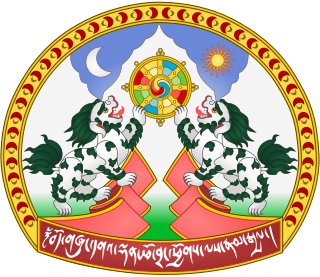
Tibetan Buddhism is the form of Buddhist doctrine and institutions named after the lands of Tibet, but also found in the regions surrounding the Himalayas and much of Central Asia. It derives from the latest stages of Indian Buddhism and preserves "the Tantric status quo of eighth-century India." It has been spread outside of Tibet, especially due to the Mongol power of the Yuan dynasty (1271–1368), founded by Kublai Khan, that also ruled China.

The Central Tibetan Administration, also known as CTA is an organisation based in India. It was originally called Tibetan Kashag Government in 1960, then later renamed to "the Government of the Great Snow Land". The CTA is also referred to as the Tibetan Government in Exile which has never been recognized by China. Its internal structure is government-like; it has stated that it is "not designed to take power in Tibet"; rather, it will be dissolved "as soon as freedom is restored in Tibet" in favor of a government formed by Tibetans inside Tibet. In addition to political advocacy, it administers a network of schools and other cultural activities for Tibetans in India. On 11 February 1991, the CTA became a founding member of the Unrepresented Nations and Peoples Organization (UNPO) at a ceremony held at the Peace Palace in The Hague, Netherlands.

The Gelug is the newest of the schools of Tibetan Buddhism. It was founded by Je Tsongkhapa (1357–1419), a philosopher and Tibetan religious leader. The first monastery he established was named Ganden, and to this day the Ganden Tripa is the nominal head of the school, though its most influential figure is the Dalai Lama. Allying themselves with the Mongols as a powerful patron, the Gelug emerged as the pre-eminent Buddhist school in Tibet and Mongolia since the end of the 16th century.

Tibetan history, as it has been recorded, is particularly focused on the history of Buddhism in Tibet. This is partly due to the pivotal role this religion has played in the development of Tibetan and Mongol cultures and partly because almost all native historians of the country were Buddhist monks.
The Tibetan independence movement is a movement for the independence of Tibet and the political separation of Tibet from China. It is principally led by the Tibetan diaspora in countries like India and the United States, and by celebrities and Tibetan Buddhists in the United States, India and Europe. The movement is not supported by the 14th Dalai Lama, who although having advocated it from 1961 to the late 1970s, proposed a sort of high-level autonomy in a speech in Strasbourg in 1988, and has since then restricted his position to either autonomy for the Tibetan people in the Tibet Autonomous Region within China, or extending the area of the autonomy to include parts of neighboring Chinese provinces inhabited by Tibetans.

Thubten Gyatso was the 13th Dalai Lama of Tibet.

Lobsang Trinley Lhündrub Chökyi Gyaltsen was the tenth Panchen Lama of the Gelug School of Tibetan Buddhism. He was often referred to simply as Choekyi Gyaltsen, although this is also the name of several other notable figures in Tibetan history.

Thubten Yeshe (1935–1984) was a Tibetan lama who, while exiled in Nepal, co-founded Kopan Monastery (1969) and the Foundation for the Preservation of the Mahayana Tradition (1975). He followed the Gelug tradition, and was considered unconventional in his teaching style.

The Kalmyk people are the only people of Europe whose national religion is Buddhism. They live in Kalmykia, a federal subject of the Russian Federation. It borders Dagestan to the south, Stavropol Krai to the southwest, Rostov Oblast to the west, Volgograd Oblast to the northwest and Astrakhan Oblast to the east. The Caspian Sea borders Kalmykia to the southeast.
Tibetan Americans are Americans of Tibetan ancestry.

The Seventeen Point Agreement, also called the Agreement of the Central People's Government and the Local Government of Tibet on Measures for the Peaceful Liberation of Tibet, or the Seventeen Point Agreement for the Peaceful Liberation of Tibet for short, is the document by which the delegates of the 14th Dalai Lama, sovereign of the de facto state of Tibet, reached an agreement in 1951 with the Central People's Government of the newly established People's Republic of China on affirming Chinese sovereignty over Tibet.

Lama is a title for a teacher of the Dharma in Tibetan Buddhism. The name is similar to the Sanskrit term guru and in use it is similar, but not identical to the western monastic rank of abbot.

The 1959 Tibetan uprising or the 1959 Tibetan rebellion began on 10 March 1959, when a revolt erupted in Lhasa, the capital of the Tibet Area, which had been under the effective control of the People's Republic of China since the Seventeen Point Agreement was reached in 1951. Armed conflict between Tibetan guerillas and the People's Liberation Army (PLA) had started in 1956 in the Kham and Amdo regions, which had been subjected to socialist reform. The guerrilla warfare later spread to other areas of Tibet and lasted through 1962.
The Golden Urn refers to a method introduced by the Qing Empire in the late-18th century to select rinpoches, lamas and other high offices within Tibetan Buddhism.

The Tibetan Parliament in Exile (TPiE), officially the Parliament of the Central Tibetan Administration, is the unicameral and highest legislative organ of the Central Tibetan Administration. It was established and is based in Dharamshala, India. The creation of this democratically elected body has been one of the major changes that the 14th Dalai Lama brought about in his efforts to introduce a democratic system of administration. Today, the Parliament consists of 45 members: ten members each from Ü-Tsang, Kham, and Amdo, the three traditional provinces of Tibet; the four major schools of Tibetan Buddhism and the traditional Bön faith elect two members each; four members are elected by Tibetans in the west: two from Europe, one from Australasia, one from North America and one from Canada. The Tibetan Parliament-in-Exile is headed by a Speaker and a Deputy Speaker, who are elected by the members amongst themselves. Any Tibetan who has reached the age of 25 has the right to contest elections to the Parliament.

The 14th Dalai Lama, religious name: Tenzin Gyatso, shortened from Jetsun Jamphel Ngawang Lobsang Yeshe Tenzin Gyatso; born Lhamo Thondup, is the current Dalai Lama. Dalai Lamas are important monks of the Gelug school, the newest school of Tibetan Buddhism which was formally headed by the Ganden Tripas. From the time of the 5th Dalai Lama to 1959, the central government of Tibet, the Ganden Phodrang, invested the position of Dalai Lama with temporal duties.

Rato Dratsang, also known as Rato Monastery, is a Tibetan Buddhist monastery or monastic university of the Gelug or "Yellow Hat" tradition. Rato was, for many centuries, one of the major monastic colleges in Tibet.
















